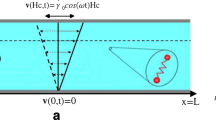Abstract
We present a methodology to analyze the stationary states and stability of complex fluid flows by using hybrid, discrete, and/or continuum multi-scale simulations. Building on existing theories, our scheme extracts dynamical and equilibrium characteristics from carefully chosen time integrations of these multi-scale evolution equations. Two canonical problems are presented to demonstrate the ability and accuracy of the formalism. The first is an investigation of flow-induced transitions seen in homogeneous, hard- rod liquid crystal suspensions subjected to a linear shear flow. In the second problem, we study the phenomenon of draw resonance, a dynamical instability in an isothermal fiber-spinning process, by using a multi-scale hybrid simulation that incorporates both stochastic and continuum models.










Similar content being viewed by others
Notes
Assuming that the long-term dynamics of the time-stepper are dictated by p slow moments, where p ≪ M, it can be shown that the GMRES iteration converges in at most p + 1 iterations, whereas for continuation, the dimension of the slow sub-space of moments increases from p to at most p + 2 (Kelley et al. 2004).
Consider the director rotated by a small angle \(\boldsymbol{\varphi}\) so that n goes to \({\bf n}+{\boldsymbol{\varphi}} \times {\bf n}\). Since \(f_{0} = f_{0}({\bf u}\boldsymbol{\cdot}{\bf n})\) and \(f_{0}^{R} = f_{0}({\bf u}\boldsymbol{\cdot} ({\bf n}+{\boldsymbol{\varphi}} \times {\bf n}))\) both satisfy Eq. (9), it follows that at linear order, \( \Psi(\boldsymbol{\varphi} \boldsymbol{\cdot} ({\bf n} \times {{\partial{f_{0}} \over \partial{\bf n}}}))=0, \) Ψ being the linearized operator corresponding to the right side of Eq. 9. Steady solutions, thus, have a neutral eigenvalue λ R = 0, characterizing the soft mode (rotation of director) with corresponding eigenvector \(\boldsymbol{\varphi} \boldsymbol{\cdot} ({\bf n} \times {\partial{f_{0}}/\partial{\bf n}})\). In terms of the Fourier coefficients, setting all the b k = 0 for k ≥ 1 is equivalent to pinning the director and removing this rotational degeneracy.
Configuration variables Q z,i and Q r,i are functions of both space and time. The standard Wiener processes W z,i and W r,i are functions of time only.
In an experimental situation, the flow rate is generally given but the initial area is unknown because of the extrudate swell and uncertainty as to the precise location of the coordinate origin.
Finite element calculations of Keunings et al. (1983) have shown that this ratio monotonically goes from − 0.5 to 0 at the point where the stresses become radially uniform, as the tension in the fiber is increased. Also, it has been shown (see Denn 1974 for instance) that the fiber-spinning equations presented here are insensitive to this stress ratio as long as it is in the range from − 0.5 to 0.
References
Anwar Z (2008) Enabling microscopic simulators to perform system-level analysis of viscoelastic flows. PhD thesis, Massachusetts Institute of Technology
Anwar Z, Armstrong RC (2008) Using Newton-GMRES for viscoelastic flow time-steppers. J Non-Newton Fluid Mech 150(1):32–42
Balay S, Buschelman K, Gropp WD, Kaushik D, Knepley MG, McInnes LC, Smith BF, Zhang H (2001) PETSc Web page. http://www.mcs.anl.gov/petsc
Bird RB, Curtiss CF, Armstrong RC, Hassager O (1987) Dynamics of polymeric liquids, vol 2. Wiley, New York
Denn MM (1974) Stability of reaction and transport processes. Prentice-Hall, Englewood Cliffs, N.J.
Fisher RJ, Denn MM (1976) A theory of isothermal melt spinning and draw resonance. AIChE J 22:236–245
Forest MG, Zhou RH, Wang Q (2004) Scaling behavior of kinetic orientational distributions for dilute nematic polymers in weak shear. J Non-Newton Fluid Mech 116(2-3):183–204
Gear CW, Kaper TJ, Kevrekidis IG, Zagaris A (2005) Projecting to a slow manifold: Singularly perturbed systems and legacy codes. SIAM Journal on Applied Dynamical Systems 4(3):711–732
Gopinath A, Armstrong RC, Brown RA (2004) Observations on the eigenspectrum of the linearized Doi equation with application to numerical simulations of liquid crystal suspensions. J Chem Phys 121(12):6093–6094
Gopinath A, Mahadevan L, Armstrong RC (2006) Transitions to nematic states in homogeneous suspensions of high aspect ratio magnetic rods. Phys Fluids 18(2):028,102
Gupta RK, Puszynski J, Sridhar T (1986) Steady spinning of the Oldroyd Fluid-B.1. Theory. J Non-Newton Fluid Mech 21(1):99–113
Ishihara H, Kase S (1975) Studies on melt spinning. V. Draw resonance as a limit cycle. J Appl Polym Sci 19(2):557–566
Jabbarzadeh A, Atkinson JD, Tanner RI (2000) Effect of the wall roughness on slip and rheological properties of hexadecane in molecular dynamics simulation of couette shear flow between two sinusoidal walls. Phys Rev E 61(1): 690–699
Jabbarzadeh A, Atkinson JD, Tanner RI (2002) The effect of branching on slip and rheological properties of lubricants in molecular dynamics simulation of couette shear flow. Tribol Int 35(1):35–46
Kase S, Matsuo T (1965) Studies on melt spinning. I. Fundamental equations on the dynamics of melt spinning. J Polym Sci, Part A, Gen Pap 3(7):2541–2554
Kelley CT (2003) Solving nonlinear equations with Newton’s method. SIAM
Kelley CT, Kevrekidis IG, Qiao L (2004) Newton–Krylov solvers for timesteppers, can be obtained as math/0404374. http://www.arxiv.org
Keunings R (2004) Micro-macro methods for the multi-scale simulation of viscoelastic flow using molecular models of kinetic theory. Rheol Rev 2:67–98
Keunings R, Crochet MJ, Denn MM (1983) Profile development in continuous drawing of viscoelastic liquids. Ind Eng Chem Fundam 22(3):347–355
Kevrekidis IG, Gear CW, Hyman JM, Kevrekidis PG, Runborg O, Theodoropoulos K (2003) Equation-free coarse grained multiscale computation: enabling microscopic simulators to perform system-level tasks. Comm Math Sci 1(4):715
Kevrekidis IG, Gear CW, Hummer G (2004) Equation-free: the computer-aided analysis of complex multiscale systems. AICHE J 50(7):1346–1355
Koppol AP, Sureshkumar R, Khomami B (2007) An efficient algorithm for multiscale flow simulation of dilute polymeric solutions using bead-spring chains. J Non-Newton Fluid Mech 141(2-3):180–192
Maffettone PL, Crescitelli S (1995) Bifurcation-analysis of a molecular-model for nematic polymers in shear flows. J Non-Newton Fluid Mech 59(1):73–91
Mass U, Pope SB (1992) Simplifying chemical kinetics: intrinsic low-dimensional manifolds in compositional space. Combust Flame 88:239–264
Matovich MA, Pearson JRA (1969) Spinning a molten threadline. steady-state isothermal viscous flows. Ind Eng Chem fundam 8(3):512–520
Nayak R (1998) Molecular simulation of liquid crystal polymer flow: a wavelet-finite element analysis. PhD thesis, Massachusetts Institute of Technology
Osswald TA, Hernández-Ortiz JP (2006) Polymer processing: modeling and simulation. Hanser, Munich
Phan-Thien N (1978) Non-linear network viscoelastic model. J Rheol 22(3):259–283
Ramírez J, Laso M (2004) Micro-macro simulations of three dimensional plane contraction flow. Model Simul Mater Sci Eng 12:1293–1306
Saad Y (2003) Iterative methods for sparse linear systems, 2nd edition. SIAM, Philadelpha, PA
Shroff GM, Keller HB (1993) Stabilization of unstable procedures: the recursive projection method. SIAM J Numer Anal 30(4):1099–1120
Smith MD, Armstrong RC, Brown RA, Sureshkumar R (2000) Finite element analysis of stability of two-dimensional viscoelastic flows to three-dimensional perturbations. J Non-Newton Fluid Mech 93(2-3):203–244
Smith MD, Joo YL, Armstrong RC, Brown RA (2003) Linear stability analysis of flow of an oldroyd-b fluid through a linear array of cylinders. J Non-Newton Fluid Mech 109(1): 13–50
Somasi M, Khomami B (2000) Linear stability and dynamics of viscoelastic flows using time-dependent stochastic simulation techniques. J Non-Newton Fluid Mech 93(2–3):339–362
Somasi M, Khomami B (2001) A new approach for studying the hydrodynamic stability of fluids with microstructure. Phys Fluids 13(6):1811–1814
Strogatz SH (2000) Nonlinear dynamics and chaos. Westview
Theodoropoulos C, Qian YH, Kevrekidis IG (2000) “Coarse” stability and bifurcation analysis using time-steppers: a reaction-diffusion example. Proc Natl Acad Sci USA 97(18): 9840–9843
Zhou H, Wang HY (2007) Steady states and dynamics of 2-D nematic polymers driven by an imposed weak shear. Communications in Mathematical Sciences 5(1):113–132
Author information
Authors and Affiliations
Corresponding author
Appendix: Numerical discretization
Appendix: Numerical discretization
The partial differential equations for the fiber-spinning process are solved by discretizing the computational domain z ∈ [0, 1] into N elements and time domain t ∈ [0,T f ] in N T steps. We then use the finite element method to discretize spatially the mass and momentum balances and the equation for the velocity gradient G. Continuous, quadratic basis functions φ i are used for A and v z , whereas continuous linear basis functions ψ i are used for G. In contrast, the polymer contributions to the stress tensor, τ p, zz and τ p, rr , and configuration fields, Q z, i and Q r, i , are discretized in space by using the discontinuous Galerkin method with local linear discontinuous basis functions \(\psi_{\text{DG},\,l}\). For time discretization, all terms are treated explicitly to yield the following algorithm.
-
1.
Given A k, \(\tau_{p,\,zz}^k\), \(\tau_{p,\,rr}^k\), and the initial guess \(v_z^k\) and G k, update the velocity and velocity gradient by solving the following nonlinear problem for the weak formulation
$$\begin{array}{lll} \int_0^1\left(\frac{\partial A^k}{\partial z}\left[-3\frac{\partial v_z^{k+1}}{\partial z}+3(1-\beta)G^{k+1}\right.\right. \\ \quad\qquad\qquad+\left.(\tau_{p,\,zz}^k-\tau_{p,\,rr}^k)\vphantom{\frac{\partial v_z^{k+1}}{\partial z}}\right] \\ \quad\quad+\;A^k\left[-3\frac{\partial^2v_z^{k+1}}{\partial z^2}+3(1-\beta)\frac{\partial G^{k+1}}{\partial z}\right. \\ \qquad\qquad\quad+\left.\left.\frac{\partial}{\partial z}\left[\tau_{p,\,zz}^k-\tau_{p,\,rr}^k\right]\vphantom{\frac{\partial^2v_z^{k+1}}{\partial z^2}}\right]\right)\phi_i\,\textrm{d}z = 0 \\ \int_0^1\Bigl(G^{k+1}-\frac{\partial v_z^{k+1}}{\partial z}\Bigr)\psi_i\,\textrm{d}z = 0 \end{array}$$(29) -
2.
Given the new velocity field update the area as follows
$$\begin{array}{lll} \int_0^1A^{k+1}\phi_i\,\textrm{d}z \notag\\ \qquad\qquad= \int_0^1A^k\phi_i\,\textrm{d}z-\Delta t\int_0^1\left(v_z^{k+1}\frac{\partial A^k}{\partial z} +A^k\frac{\partial v_z^{k+1}}{\partial z}\right)\phi_i\,\textrm{d}z\end{array}$$(30) -
3.
Update the polymer contributions to the stress tensor for the Oldroyd-B model by using the following weak formulations over each element [z j ,z j + 1] of the domain
$$\begin{array}{lll} \int_{z_j}^{z_{j+1}}\text{De}\tau^{k+1}_{p,\,zz}\psi_{\text{DG},\,l}\,\textrm{d}z\\ \qquad= \int_{z_j}^{z_{j+1}}\text{De}\tau^k_{p,\,zz}\psi_{\text{DG},\,l}\,\textrm{d}z\\ \qquad\qquad +\;\Delta t\int_{z_j}^{z_{j+1}}\left(-2(1-\beta)G^{k+1} -\tau^k_{p,\,zz}\vphantom{\frac{\partial\tau^k_{p,\,zz}}{\partial z}}\right.\\ \qquad\qquad\qquad +\;2\text{De}G^{k+1}\tau^k_{p,\,zz}\\ \qquad\qquad\qquad-\left.v_z^{k+1}\frac{\partial\tau^k_{p,\,zz}}{\partial z}\right)\psi_{\text{DG},\,l}\,\:\textrm{d}z\:+ {\mathcal{Z}}_{1}\\ \qquad\times\begin{cases} {\mathrm{For}}\:\:\: v_z^{k+1}\Bigr\lvert_{z_j}\:\:\:\:>0 \\[6pt] {\mathcal{Z}}_{1} = \Delta t\:\text{De}\left({\psi_{\text{DG},\,l}}v_z^{k+1}(\tau_{p,\,zz}^{k,\text{ex}}-\tau_{p,\,zz}^{k,\text{in}})\right)\Bigr\lvert_{z_j}\\[6pt] {\mathrm{For}}\:\:\: v_z^{k+1}\Bigr\lvert_{z_{j+1}}<0\\[6pt] {\mathcal{Z}}_{1} = -\Delta t\:\text{De}\left({\psi_{\text{DG},\,l}}v_z^{k+1}(\tau_{p,\,zz}^{k,\text{ex}}-\tau_{p,\,zz}^{k,\text{in}})\right)\Bigr\lvert_{z_{j+1}} \end{cases}\\ \end{array}$$(31)$$\begin{array}{lll} \int_{z_j}^{z_{j+1}}\text{De}\tau^{k+1}_{p,\,rr}\psi_{\text{DG},\,l}\,\textrm{d}z\\ \;\;= \int_{z_j}^{z_{j+1}}\text{De}\tau^k_{p,\,rr}\psi_{\text{DG},\,l}\,\textrm{d}z\\ \qquad +\Delta t\int_{z_j}^{z_{j+1}}\left((1-\beta)G^{k+1} -\tau^k_{p,\,rr}-\text{De}G^{k+1}\tau^k_{p,\,rr}\vphantom{\frac{\partial\tau^k_{p,\,rr}}{\partial z}}\right.\\ \qquad\qquad\qquad-\left.v_z^{k+1}\frac{\partial\tau^k_{p,\,rr}}{\partial z}\right)\psi_{\text{DG},\,l}\,\textrm{d}z\:+\:{\mathcal{Z}}_{2}\\ \qquad\times\begin{cases} {\mathrm{For}} \:\:\: v_z^{k+1}\Bigr\lvert_{z_j}\:\:\:\:>0 \\[4pt] {\mathcal{Z}}_{2} = \Delta t\:\text{De}\left({\psi_{\text{DG},\,l}}v_z^{k+1}(\tau_{p,\,rr}^{k,\text{ex}}-\tau_{p,\,rr}^{k,\text{in}})\right)\Bigr\lvert_{z_j}\\[4pt] {\mathrm{For}}\:\:\:v_z^{k+1}\Bigr\lvert_{z_{j+1}}<0 \\[4pt] {\mathcal{Z}}_{2} = -\Delta t\:\text{De}\left({\psi_{\text{DG},\,l}}v_z^{k+1}(\tau_{p,\,rr}^{k,\text{ex}}-\tau_{p,\,rr}^{k,\text{in}})\right)\Bigr\lvert_{z_{j+1}} \end{cases} \end{array}$$(32)For the Hookean dumbbell model, instead, we lift \(\tau_{p,\,zz}^k\) and \(\tau_{p,\,rr}^k\) to a consistent ensemble of molecular configurations \(\{Q^k_{z,\,i},Q^k_{r,\,i}\}\) that are then evolved using the following weak formulations
$$\begin{array}{lll} \int_{z_j}^{z_{j+1}}Q^{k+1}_{z,\,i}\psi_{\text{DG},\,l}\,\textrm{d}z\\ \;\;=\int_{z_j}^{z_{j+1}}Q^{k}_{z,\,i}\psi_{\text{DG},\,l}\,\textrm{d}z\\ \quad+\;\Delta t\int_{z_j}^{z_{j+1}}\left[-v_z^{k+1}\frac{\partial Q^k_{z,\,i}}{\partial z}+G^{k+1}Q^k_{z,\,i} \right.\\ \qquad\qquad\qquad-\left.\frac{1}{2\text{De}}Q^k_{z,\,i}\vphantom{\frac{\partial Q^k_{z,\,i}}{\partial z}}\right]\psi_{\text{DG},\,l}\,\textrm{d}z \\ \quad+\Delta W_{z,\,i}\int_{z_j}^{z_{j+1}}\psi_{\text{DG},\,l}\,\textrm{d}z\:+\:{\mathcal{Z}}_{3}\\ \quad\times\begin{cases} {\mathrm{For}}\:\:\:v_z^{k+1}\Bigr\lvert_{z_j}>0 \\ {\mathcal{Z}}_{3} = \Delta t\:\left({\psi_{\text{DG},\,l}}v_z^{k+1}(Q^{k,\text{ex}}_{z,\,i}-Q^{k,\text{in}}_{z,\,i})\right)\Bigr\lvert_{z_j}\\ {\mathrm{For}}\:\:\:v_z^{k+1}\Bigr\lvert_{z_{j+1}}<0 \\ {\mathcal{Z}}_{3} = -\Delta t\:\left({\psi_{\text{DG},\,l}}v_z^{k+1}(Q^{k,\text{ex}}_{z,\,i}-Q^{k,\text{in}}_{z,\,i})\right)\Bigr\lvert_{z_{j+1}} \end{cases} \end{array}$$(33)$$\begin{array}{lll} \int_{z_j}^{z_{j+1}}Q^{k+1}_{r,\,i}\psi_{\text{DG},\,l}\,\textrm{d}z\\ \;\;=\int_{z_j}^{z_{j+1}}Q^{k}_{r,\,i}\psi_{\text{DG},\,l}\,\textrm{d}z\\ \quad +\Delta t\int_{z_j}^{z_{j+1}}\left[-v_z^{k+1}\frac{\partial Q^k_{r,\,i}}{\partial z}-\frac{G^{k+1}}{2}Q^k_{r,\,i} \right.\\ \qquad\qquad\qquad-\left.\frac{1}{2\text{De}}Q^k_{r,\,i}\vphantom{\frac{\partial Q^k_{r,\,i}}{\partial z}}\right]\psi_{\text{DG},\,l}\,\textrm{d}z\\ \quad +\Delta W_{r,\,i}\int_{z_j}^{z_{j+1}}\psi_{\text{DG},\,l}\,\textrm{d}z\:+\: {\mathcal{Z}}_{4}\\ \quad\times\begin{cases} {\mathrm{For}}\:\:\:v_z^{k+1}\Bigr\lvert_{z_j}>0 \\[6pt] {\mathcal{Z}}_{4} = \Delta t \:\left({\psi_{\text{DG},\,l}}v_z^{k+1}(Q^{k,\text{ex}}_{r,\,i}-Q^{k,\text{in}}_{r,\,i})\right) \Bigr\lvert_{z_j}\\[6pt] {\mathrm{For}}\:\:\:v_z^{k+1}\Bigr\lvert_{z_{j+1}}<0 \\[6pt] {\mathcal{Z}}_{4} = -\Delta t\:\left({\psi_{\text{DG},\,l}}v_z^{k+1}(Q^{k,\text{ex}}_{r,\,i}-Q^{k,\text{in}}_{r,\,i})\right)\Bigr\lvert_{z_{j+1}} \end{cases}\\ \end{array}$$(34)For the Hookean dumbbell simulation, another ensemble of equilibrium configurations \(\{\hat{Q}^k_{z,\,i},\hat{Q}^k_{r,\,i}\}\) are also initialized that have the same initial configuration as \(\{Q^k_{z,\,i},Q^k_{r,\,i}\}\). These are then subjected to the same Wiener process and evolved according to a similar weak form with \(v_z^{k+1}\) and G k + 1 equal to zero. The evolved configurations for the flow field and quiescent state are then used to evaluate the updated stress field, \(\tau_{p,\,zz}^{k+1}\) and \(\tau_{p,\,rr}^{k+1}\).
-
4.
Repeat steps 1–3 with A k + 1, \(\tau_{p,\,zz}^{k+1}\), \(\tau_{p,\,rr}^{k+1}\), \(v_z^{k+1}\), and G k + 1 until t = T f .
In the discontinuous Galerkin method, the weak form of the advection term has been replaced with the sum of an integral over the element [z j ,z j + 1] and a jump term that is only evaluated at inflow boundaries. Specifically, terms labeled \(\tau_{p,\,rr}^{k,\text{ex}}\) are evaluated upstream of a given element, while terms labeled \(\tau_{p,\,rr}^{k,\text{in}}\) are evaluated within the element itself. If a boundary, z j or z j + 1 is not an inflow boundary, the jump term at that boundary is equal to zero. Also, in the weak formulation for the Hookean dumbbell configuration, the same Wiener process (ΔW z, i or ΔW r, i ) is applied to all points in space. In writing the weak formulation for the dumbbell configuration, the Wiener process has been scaled by \(\sqrt{\Delta t/\text{De}}\).
Rights and permissions
About this article
Cite this article
Anwar, Z., Gopinath, A. & Armstrong, R.C. Systems analysis of hybrid, multi-scale complex flow simulations using Newton-GMRES. Rheol Acta 51, 849–866 (2012). https://doi.org/10.1007/s00397-012-0645-7
Received:
Revised:
Accepted:
Published:
Issue Date:
DOI: https://doi.org/10.1007/s00397-012-0645-7




